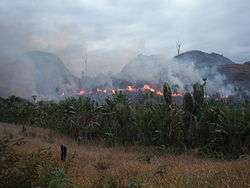Deforestation in Madagascar

Deforestation in Madagascar is an ongoing environmental issue of. kai [1] creates agricultural or pastoral land but can also result in desertification, water resource degradation, biodiversity erosion and habitat loss, and soil loss.
It has been noticed that Madagascar has lost 80 or 90% of its 'original' or 'pre-human' forest cover, but this claim is difficult to prove and is not supported by evidence.[2][3] What is certain is that the arrival of humans on Madagascar some 2000+ years ago began a process of fire, cultivation, logging and grazing that has reduced forest cover. Industrial forest exploitation during the Merina monarchy[4] and French colonialism[5] contributed to forest loss. Evidence from air photography and remote sensing suggest that by c. 2000, around 40% to 50% of the forest cover present in 1950 was lost.[3][6][7] Current hotspots for deforestation include dry forests in the southwest being converted for maize cultivation and rain forests in the northeast exploited for tropical hardwoods.[8]
Primary causes of forest loss include slash-and-burn for agricultural land (a practice known locally as tavy) and for pasture, selective logging for precious woods or construction material, the collection of fuel wood (including charcoal production), and in certain sites, forest clearing for mining.[9]
Illegal logging
Illegal logging in Madagascar has been a problem for decades and is perpetuated by extreme poverty and government corruption. Often taking the form of selective logging, the trade has been driven by high international demand for expensive, fine-grained lumber such as rosewood and ebony. Historically, logging and exporting in Madagascar have been regulated by the Malagasy government, although the logging of rare hardwoods was explicitly banned from protected areas in 2000. Since then, government orders and memos have intermittently alternated between permitting and banning exports of precious woods. The most commonly cited reason for permitting exports is to salvage valuable wood from cyclone damage, although this reasoning has come under heavy scrutiny. This oscillating availability of Malagasy rosewood and other precious woods has created a market of rising and falling prices, allowing traders or "timber barons" to stockpile illegally sourced logs during periodic bans and then flood the market when the trade windows open and prices are high.
Reforestation efforts
Despite the deforestation trend, tree cover is increasing in some parts of the country, though largely of introduced (non-native) species such as Eucalyptus (various species), pine (Pinus kesiya, Pinus patula,) silver wattle (Acacia dealbata), silky oak (Grevillea banksii), and paperbark/niaouli ("Melaleuca quinquenervia"). Some of these trees are planted by foresters and farmers; others have become invasive of their own accord.[10][11][12] Reforestation by eucalypts, pines, and wattles has been demonstrated, for instance, in the central highlands.[13]
Reforestation efforts with native species, particularly in rainforest corridors, have had mixed success. Some reforestation efforts have been conducted by Rio Tinto, a mining organization. This effort includes the set-up of 2 tree nurseries near Fort Dauphin. The nurseries are called the Rio Tinto QMM's nurseries. The nurseries plant some 600 tree species native to Madagascar.[14][15] However, in 2003, Rio Tinto also announced plans to mine ilmenite (used to make toothpaste and paint) in southern Madagascar. These plans included the creation of a new port, roads, and other facilities. Mostly migrant workers would be employed, despite high levels of unemployment in the region. This unemployment and poverty drives charcoal production, which is a major factor in deforestation in that region.[16]
See also
- Environment of Madagascar
- Forestry in Madagascar
- Deforestation by region
References
- ↑ Saving the Wildlife of Madagascar, TIME, September 25, 2008
- ↑ McConnell, William; Kull, Christian (2014). "Protecting lemurs: Madagascar's forests". Science. 344: 358. doi:10.1126/science.344.6182.358-a.
- 1 2 McConnell, William; Kull, Christian (2014). "Deforestation in Madagascar: debates over the island's forest cover and challenges of measuring forest change" (PDF). Conservation and Environmental Management in Madagascar, ed. Ivan R. Scales (London, Routledge-Earthscan): 67–104.
- ↑ Campbell, Gwyn (2013). "Forest Depletion in Imperial Madagascar, c.1790–1861". Contest for Land in Madagascar: Environment, Ancestors and Development, edited by S. Evers, G. Campbell & M. Lambek (Leiden: Brill).: 63–96.
- ↑ Jarosz, Lucy (1993). "Defining and explaining tropical deforestation: shifting cultivation and population growth in colonial Madagascar (1896-1940)". Economic Geography. 69 (4): 366–379. doi:10.2307/143595. PMID 12318844.
- ↑ Allnutt, Thomas; et al. (2008). "A method for quantifying biodiversity loss and its application to a 50-year record of deforestation across Madagascar". Conservation Letters. 1 (4): 173–181. doi:10.1111/j.1755-263X.2008.00027.x.
- ↑ Deforestation causes species extinction in Madagascar
- ↑ Harper, Grady; Steininger, Marc; Tucker, Compton; Juhn, Daniel; Hawkins, Frank (2007). "Fifty years of deforestation and forest fragmentation in Madagascar". Environmental Conservation. 34 (4): 325–333. doi:10.1017/s0376892907004262.
- ↑ Mittermeier, R.A.; Konstant, W.R.; Hawkins, F.; Louis, E.E.; Langrand, O.; Ratsimbazafy, J.; Rasoloarison, R.; Ganzhorn, J.U.; Rajaobelina, S.; Tattersall, I.; Meyers, D.M. (2006). "Chapter 4: Conservation of Lemurs". Lemurs of Madagascar. Illustrated by S.D. Nash (2nd ed.). Conservation International. pp. 52–84. ISBN 1-881173-88-7.
- ↑ Carriere, Stephanie; Randriambanona. "Biodiversité introduite et autochtone: antagonisme ou complémentarité? Le cas de l'eucalyptus à Madagascar" (PDF). Bois et Forêts des Tropiques. 292 (2): 5–21.
- ↑ Kull, Christian; Tassin, Jacques; Rangan, Haripriya. "Multifunctional, scrubby, and invasive forests? Wattles in the highlands of Madagascar". Mountain Research and Development. 27 (3): 224–231. doi:10.1659/mrd.0864.
- ↑ Tassin, Jacques (2009). "Evaluation préliminaire des risques d'invasion par les essences forestières à Madagascar" (PDF). Bois et Forets des Tropiques. 299 (1): 27–36.
- ↑ Kull, Christian (2012). "Air photo evidence of historical land cover change in the highlands: wetlands and grasslands give way to crops and woodlots". Madagascar Conservation and Development. 7 (3): 144–152. doi:10.4314/mcd.v7i3.7.
- ↑ IUCN report on Rio Tinto mines in Madagascar
- ↑ Indian Ocean With Simon Reeve documentary
- ↑ "Deforestation of Tropical Rainforests - A Case Study of Madagascar" (PDF). Geocases. 2005. Archived from the original on 30 October 2013. Retrieved 30 October 2013.
